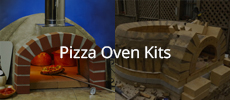Re: Share your crack stories
Gudday
All the courses in the dome are technically stretcher courses of course. What makes them a sailor is the lower 2 (or 3?) are layed so to form a vertical wall the next courses are curved to meet a the top of the dome.
This is done to give more useable space alongside the dome walls on a smaller lower domed oven. A bigger dia oven with a higher dome would have a larger angle making this less a requirement.
I will take correction on this but I think this covers it
Regards Dave
Announcement
Collapse
No announcement yet.
Share your crack stories
Collapse
X
-
Re: Share your crack stories
Wot - I think you mean stretcher course, not sailor course - to the picture that Brickie posted a while back? Half bricks laid with a 4.5" W x 2.5" tall face into the oven?
Do I have this term right?
Leave a comment:
-
Re: Share your crack stories
Interesting...how old is the oven?Originally posted by wotavidoneSo far, none that I can see. Maybe, if I let my imagination run wild, I can see some hairline cracks where mortar has released from bricks on one side of a join, but I ridgey didge am not actually sure about that. Some days I reckon I can see 'em, some days I reckon I can't.
Maybe, if I let my imagination run wild, I can see some hairline cracks where mortar has released from bricks on one side of a join, but I ridgey didge am not actually sure about that. Some days I reckon I can see 'em, some days I reckon I can't.
It certainly isn't like some poor unfortunates who can insert a matchstick in their dome cracks.
The only crack I can see for sure is in the inner arch about halfway up one side it looks like the mortar has released from the brick on one side of a mortared joint.
And, hot or cold, that crack can genuinely be classified as "hairline".
I find myself wondering how this came to be. No fire brick, no fire clay, no specialist mortar, sailor course mortared to the slab, mix and match bricks, rather fast "curing" schedule.
Is it that I rendered the outside of the dome with a high lime, chicken wire reinforced 1 inch layer?
Is it that the dome is only 750mm internal diameter.
Is it that I couldn't find an affordable source of fire clay and used my own natural clay that my consultant geologist classified as "silty clay"? (It was the freight that killed every option I explored.)
I feel that your reinforced cladding is what is keeping the sailor course from failing. I'm assuming you are only one wythe for your sailor course.
As a side point, good for you for pushing forward and building the oven with what you have.
Leave a comment:
-
Re: Share your crack stories
Could be all of those, but probably mostly the last option.Originally posted by wotavidoneSo far, none that I can see. Maybe, if I let my imagination run wild, I can see some hairline cracks where mortar has released from bricks on one side of a join, but I ridgey didge am not actually sure about that. Some days I reckon I can see 'em, some days I reckon I can't.
Maybe, if I let my imagination run wild, I can see some hairline cracks where mortar has released from bricks on one side of a join, but I ridgey didge am not actually sure about that. Some days I reckon I can see 'em, some days I reckon I can't.
It certainly isn't like some poor unfortunates who can insert a matchstick in their dome cracks.
The only crack I can see for sure is in the inner arch about halfway up one side it looks like the mortar has released from the brick on one side of a mortared joint.
And, hot or cold, that crack can genuinely be classified as "hairline".
I find myself wondering how this came to be. No fire brick, no fire clay, no specialist mortar, sailor course mortared to the slab, mix and match bricks, rather fast "curing" schedule.
Is it that I rendered the outside of the dome with a high lime, chicken wire reinforced 1 inch layer?
Is it that the dome is only 750mm internal diameter.
Is it that I couldn't find an affordable source of fire clay and used my own natural clay that my consultant geologist classified as "silty clay"? (It was the freight that killed every option I explored.)
Or is it, as I suspect, pure arse, as we say in Oz?
Leave a comment:
-
Re: Share your crack stories
Interesting discussion.....once I find pics of my old oven I can poll.
The other thing if its sitting on soft and spongy insulation brickie......could that be a good thing in actually allowing for movement????
Leave a comment:
-
Re: Share your crack stories
He is a genius, but wait, isnt all clay silty clay?Originally posted by wotavidonemy consultant geologist classified as "silty clay"?
I hope you didnt pay him?
Leave a comment:
-
Re: Share your crack stories
I believe that having the weight of the oven sitting on the hearth spreads the weight a little more evenly than the oven just sitting on the insulation, the insulation, which ever you choose to use is soft and spongy.Originally posted by Bacterium View PostI actually tend to favour your position
But
What about when you have the floor all the way out and you have all that weight sitting on top. Even thought the dome is "free floating" does the dome actually float.
Meaning does all that weight of the dome prevent the bottom course expanding outwards.
I really doubt that any dome floats assuming 300 bricks at 3kgs each.
Thats a lot of mass pushing down on a spongy insulation.
Spread that weight around a little on the hearth.
Leave a comment:
-
Re: Share your crack stories
I actually tend to favour your position
But
What about when you have the floor all the way out and you have all that weight sitting on top. Even thought the dome is "free floating" does the dome actually float.
Meaning does all that weight of the dome prevent the bottom course expanding outwards.
Leave a comment:
-
Re: Share your crack stories
Maybe we need a poll thread to see?Originally posted by Bacterium View PostPoint taken brickie.......
so for those out there who have built the floor inside, rather than underneath, how much cracking seem to have occurred.
Leave a comment:
-
Re: Share your crack stories
Point taken brickie.......
so for those out there who have built the floor inside, rather than underneath, how much cracking seem to have occurred.
Leave a comment:
-
Re: Share your crack stories
Building the oven and cutting the floor to fit inside is in my opinion all wrong and a waste of time, no one in their life time is going to replace a hearth brick, then there is the danger of something getting stuck in the gap and forcing the oven out as it expands.
Building the oven on the floor makes sense as it all expands and contracts at the same rate, if there is a difference it will be so small that you would need a micrometer to measure the difference.
Leave a comment:
-
Re: Share your crack stories
Brickie,
Can you expand on building it correctly? My soldier course is on the floor. I did make teh mistake or using a thin layer or Mortar. It looks like my floor expands and contracts. A couple of mm here and there. I am sure I did something wrong and want to understand it. No matter, my WFO keeps getting better each time I fire it up.
Leave a comment:
-
Re: Share your crack stories
Only if its built wrongly.Originally posted by Bookemdanno View PostI'd like to float the idea of hearth expansion forcing the first ring out?
Leave a comment:
-
Re: Share your crack stories
I'd like to float the idea of hearth expansion forcing the first ring out?
Leave a comment:
-
Re: Share your crack stories
Nice one, lots of oven owners give their ovens names. I think your solution for the dome base is a good one. The only downside that I can see is that as the base of the dome is the most difficult area to get heat into, you may find that yours will take a little longer to saturate with heat in that area, but not that you would notice.
Leave a comment:





Leave a comment: